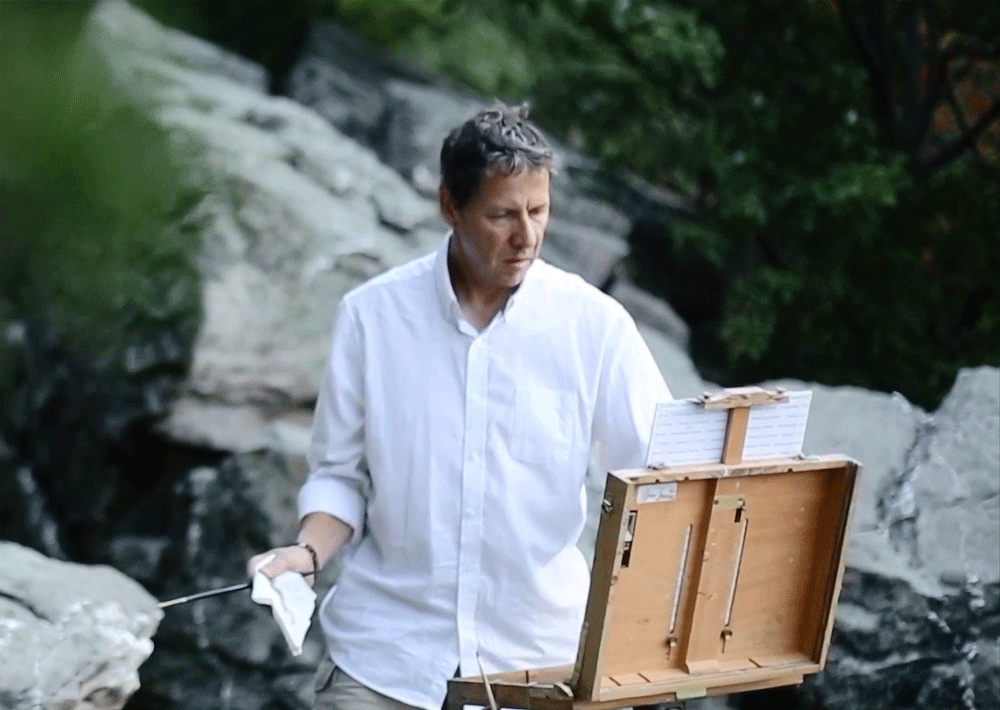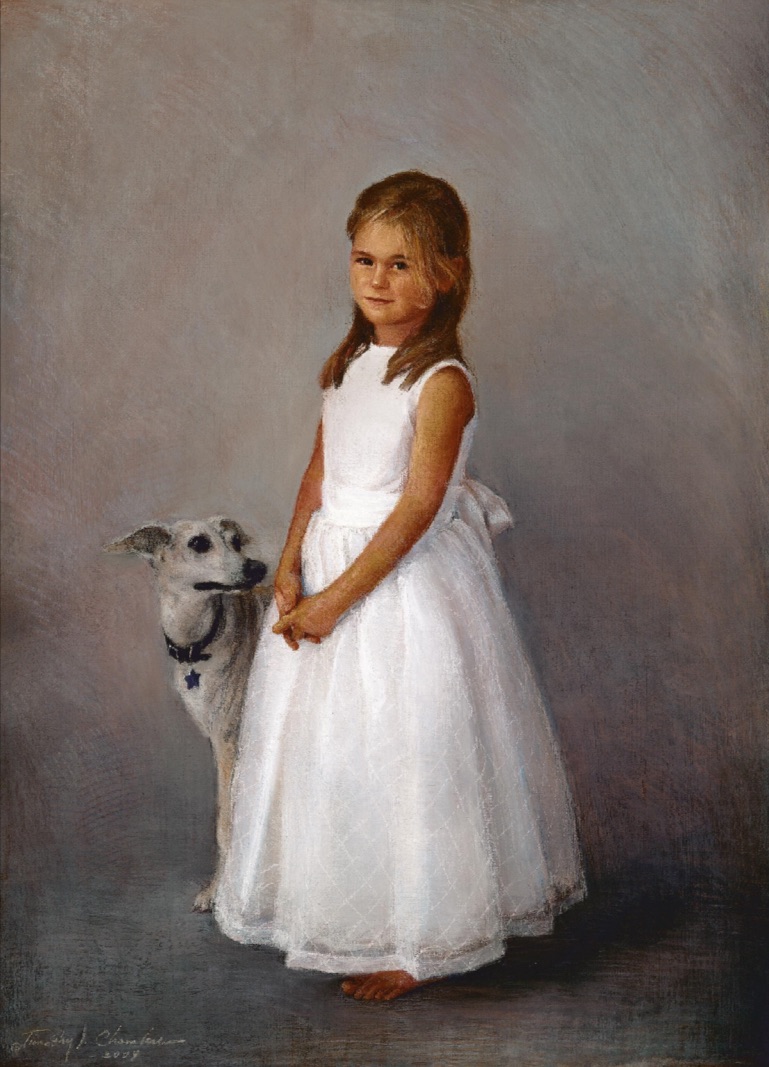Paradox of a Painter

By Wendy C. Kedzierski
“I’m nearly deaf. I’m nearly blind. And I’m an artist.” – Tim Chambers

It’s late summer in the Shenandoah Valley, and landscape and portrait artist Tim Chambers heads out of his studio at sunrise, armed with paint and canvas to record the morning light. The foreground is golden sunlight glistening on 19th century silver metal roofs; the background is pure pink sky met by blue-gray Blue Ridge Mountains.
“There is something wonderfully intoxicating about the morning,” says Chambers. “I think it reminds me that I get a new start each morning to enjoy life, people, the beauty of creation. I find that this makes life better and makes facing challenges a little easier.”
But 25 years ago the challenges Chambers faced were debilitating. The harsh words of a doctor – “You’re going blind. It’s time to find another profession.” – plunged the young artist into the depths of despair and professional and personal paralysis.
Chambers has Usher syndrome, a degenerative ear and eye disease. At this point in his life, his hearing is 20 percent of a normal hearing person, a disability he has learned to live with since he was born. He has worn hearing aids since kindergarten. But it’s the gradual visual impairment that seemed the cruelest twist of fate. While the normal peripheral range for humans is anywhere from 180 to 200 degrees, Chambers’ range has deteriorated to less than 17 degrees. Less than 10 percent of normal vision. And Chambers is a visual artist.
“Vision is the art of seeing what is invisible to others.” – Jonathan Swift

For Chambers, finding another career is like telling someone to find another way to breathe. “I probably made my career choice by the time I was 3,” he says. “I love art. I can’t imagine being anything else. It’s how I process thoughts, take in anything in life. I think visually. I see moments as paintings. I always knew I was going to be an artist. And when my dad saw my resolve to be a painter, he gave me his blessing to pursue the best training.”
Chambers’ father, William Chambers, a renowned oil portrait artist whose high-profile subjects have included Steven Spielberg and former President Bill Clinton, had set a high standard. He also understood his son’s calling and not only mentored him but sought out the best teachers he could find.
The young Chambers started out studying art at a large university, but he was not feeling challenged since at that time abstract, psychological-based art was the norm. “Even the best colleges were about conveying feeling, sans skill,” recalls Chambers. “I was taught that the only absolute was that there were no absolutes. I wasn’t getting the training I needed to be a skilled painter. Skill is necessary to success. I was frustrated, not learning what I needed.”
Chambers’ father then suggested Atelier Lack, a studio art program in Minnesota. There, Chambers and 11 other apprentices studied under founder Richard Lack, considered to be one of the most significant American realists of the second half of the 20th century. At a time when non-traditional forms of art were garnering much artistic and public recognition, Lack’s studio sought to train his young artists in the artistic traditions of Europe.
“Studying at Atelier Lack was a great experience, as I learned centuries-old practices of drawing and painting,” says Chambers.
There, he also studied under Stephen Gjertson, a well-known “Classical Realist,” and a founding member of the American Society of Classical Realism Guild of Artists.
“Both were patient, kind, serious teachers, generous and enthusiastic to instruct us,” he says.

From Atelier Lack, Chambers headed to The Cape School of Art in Provincetown, Massachusetts, a school that was founded by American master Charles Hawthorne—student of another master, William Merritt Chase—in 1899. Artists who sought Hawthorne’s instruction included Norman Rockwell, Max Bohm and Richard Miller.
Henry Hensche had been taught by Hawthorne, and now Chambers was learning from Hensche—a strong American lineage in the making.
Hensche’s paintings are breathtaking studies of light and color—an area in which the young Chambers was untrained. “Color will come,” Chambers’ father had counseled. “First excel at drawing, Tim.”
Chambers remembers a frustrating exercise where Hensche had his students outside painting, using colored blocks as their subjects. Sounds simple, but Chambers was struggling trying to perfectly capture the different shades of a yellow block. Hensche saw Chambers’ muddled attempt and took over his palette and brush.
“I watched as Henry drew from my piles of violet, blue, red and white, to paint the most stunning, beautiful, true yellow block I’ve ever seen,” marvels Chambers. “He barely even used any yellow. I was stunned. I was hooked. Suddenly, I realized every color was evident and permissible. He had blown away the old, restricted rules that kept me from seeing.”
As Henry handed Chambers’ palette back to him, he said, “This weekend, go to the Gardner in Boston and look at the Monets.”
Chambers had never even heard of Monet, but he followed Hensche’s instruction. And it was at the Gardner that Chambers had his second color epiphany as he drank in the Haystack paintings.
“The colors were lifelike, full of sun, full of air, full of truth,” he says. “My life would never be the same. Truly, color is what sets me and a few others apart from many, perhaps most, artists today.”
More color study followed, with some time in Annapolis, Maryland, under Cedric Egeli, a widely acclaimed artist and teacher, and an Exceptional Member of the American Portrait Society.
Chambers’ professional career took off quickly. He was winning awards and receiving commissions. Personally, he was happily married, and he and his wife had begun adding to their family. “I was doing well,” remembers Tim, “and I envisioned that it wouldn’t be long until I was painting presidents and Supreme Court justices, with my portraits hanging alongside other great paintings in Washington. The future was bright.”
And then … the diagnosis.
“The only thing worse than being blind is having sight but no vision.” – Helen Keller
Chambers was 30 when he went in for his annual routine eye checkup. The doctor realized something was very wrong and referred Chambers to a retinal specialist near Washington, D.C. It was there that he learned he had Usher syndrome, an inherited condition characterized by progressive vision loss and hearing impairment.
The vision loss is due to a disorder called retinitis pigmentosa (RP). RP causes night-blindness and a loss of peripheral vision through the progressive degeneration of the retina. As RP progresses, the field of vision narrows (creating “tunnel vision”) until only the ability to see straight ahead remains.
Chambers’ future, in his mind, was no longer bright. “It was stark. Midnight black,” he says. ‘I was an artist. I saw the world in living color. In a blink, my identity was shaken. Gone. If I can’t see or hear, how am I going to experience life, let alone paint?”
It was terrifying. Night after night, he woke up in a cold sweat, imagining himself completely blind, completely deaf, relegated to a corner of his house just waiting for someone to periodically touch him to make sure he was still alive.
“I mean, what’s the point?” he thought.
For two years, Chambers agonized over his diagnosis.

of Tim Chambers.
“I feared that my life would become nothing, that I would have nothing to offer. I feared that I would be forgotten, dismissed, losing all dignity, a mere inconvenience in the lives of those who could still live fully,” he recalls.
The words of the physician, “Find another profession,” taunted him, an infinite loop playing mercilessly in his head.
And then he slowly began to resurface, with the help of his wife, Kim, along with the encouragement from a couple of doctors who told him, “Go live!” and, “Paint until you can’t!”
He realized that he needed to live in the present. That he had succumbed to tunnel vision years ago, in a figurative sense. “I had been running 100 miles an hour toward something fixed in the distance: that I was going to be a great artist one day,” he says. “But the future was nothing more than a mirage. It could happen, but nobody really knows what’s going to happen. When I was running toward the future, the past and the present went by so fast that I was missing life.”
So he began to slow down. And as he did, he says he saw so much more beauty.
His emotional recovery wasn’t immediate. It was a deliberate, conscious process.
“I had a wall in my studio where I began to write down truths as I came across them. There were times when I was painting, and out of the blue, one fearful whisper after another would have me reeling, feeling like I was on a two-mile drop on a roller coaster,” he says. “I would read the truths on my wall and steadily recover. Truths that reminded me to focus on today, not tomorrow.”
“Your vision will become clear only when you can look into your own heart. Who looks outside, dreams; who looks inside, awakes.” – Carl Jung
“This artist sees the world beautifully.” These were the words used by a judge at the Waterford Art Exhibit who awarded Chambers a Best of Show and Best Oil Painting among 600 entries.
Chambers’ work continues to improve, despite his declining vision. Perhaps it is the tunnel vision that allows him to micro-focus on his subjects. Perhaps it is his renewed zest for life and love of people.
Painting with diminished vision is “a bit challenging,” admits Chambers. “On the other hand, 10 percent is eons more than nothing. I’m thankful that I can see at all. When I wake up in the morning and search for my alarm clock—and find it—I’m thrilled to see. Yes, the limited vision definitely presents an ever-present challenge, but at this point, it’s a surmountable challenge.”
Chambers says he no longer takes things for granted, including the gift of earning a living doing what he loves. And he believes that his paintings are actually much “better, fuller, richer” since emerging from the darkness of his despair and into the light that is his life.
“The quality of my work hasn’t suffered but actually has improved due to ever-growing experience and insight,” says Chambers. “The talent hasn’t reached its capacity or threshold yet.”
Chambers’ work has a depth that many artists never achieve. He attributes some of this to “God-given talent” but most to the training and vision cast by his teachers including his father and Egeli—two
tremendous portrait artists—and Hensche, “perhaps the best colorist (more accurate term than ‘Impressionist’) in America’s history,” according to Chambers.
“All three artists taught me to pursue truth—the truth of what is seen. The trick then, of course, is threefold: first, to have eyes/talent to see; the second to recognize what it is you’re looking at; and thirdly to assimilate and respond with skill,” he says.
And Chambers’ productivity has increased and diversified.
In 2014, Chambers started Iguana Art Academy, an online art school with a key element of “I do, you do,” which incorporates step-by-step demonstrations in each art lesson.
In June of 2017, Tim’s book “Seeing Beautiful” was published by BroadStreet Publishing. Classified as an “adult coloring book,” it also offers Chambers’ encouragement, stories and guidance on how to color.
And in September of 2017, Chambers gave a TED talk, telling his inspiring story to others.
But portraiture is still Chambers’ driving professional passion, only now he says that instead of simply projecting confidence in his portraits, he engages his heart with his brush and pen.
“People intrigue me,” says Chambers. “Every person has a story, a God-given dignity, an eternal intrigue about them that appeals to me. I love painting people. I truly enjoy getting to know people, honing in on the subject’s personality, demeanor, mannerisms and their story.”
Chambers’ story is still being written—in the present tense.
“I don’t really know what direction my life and mindset will go,” he says. “I’m here right now. I can think clearly, handle a brush, and love. That’s more than enough.” ML


